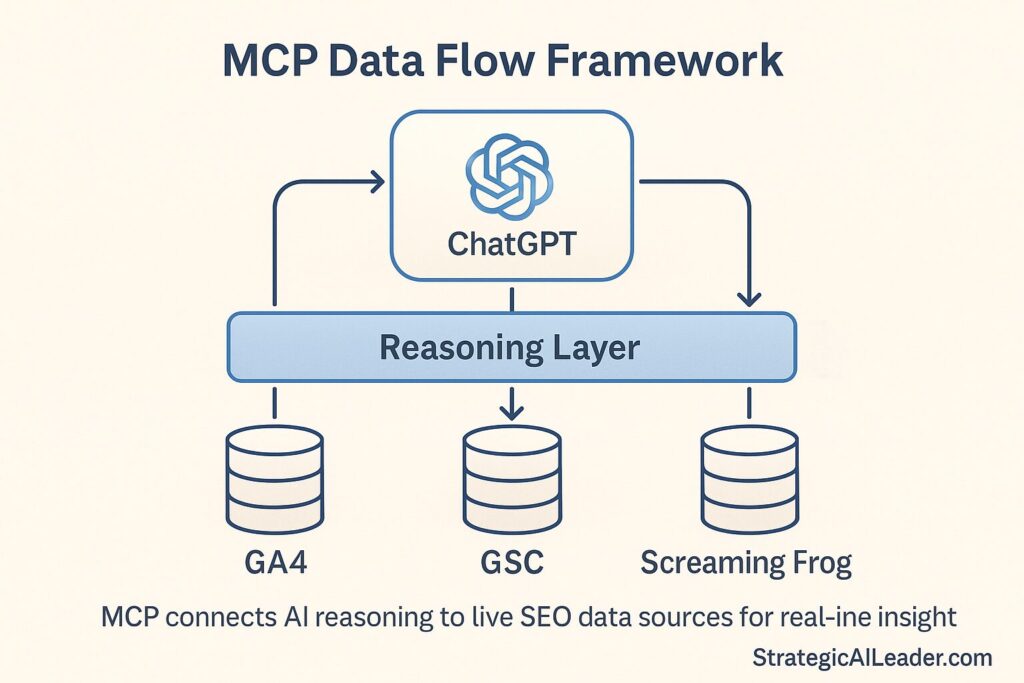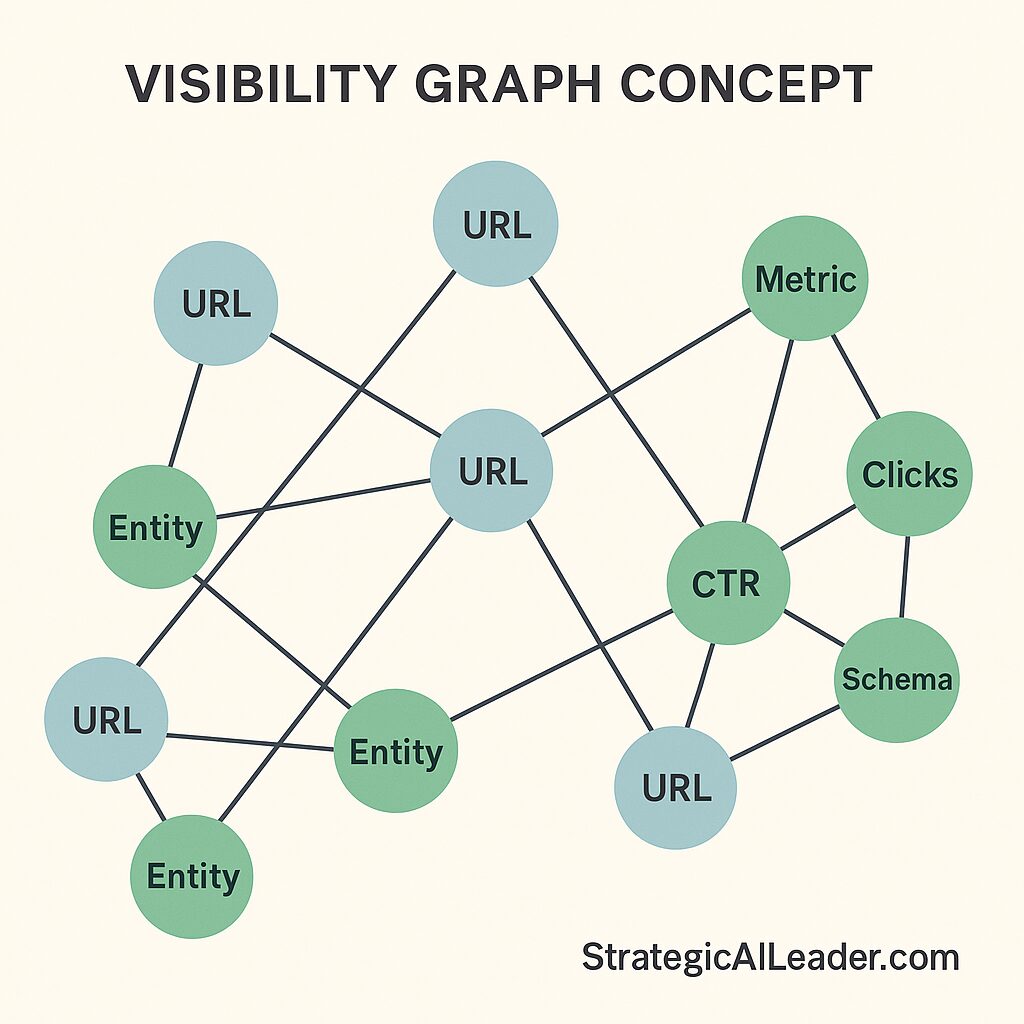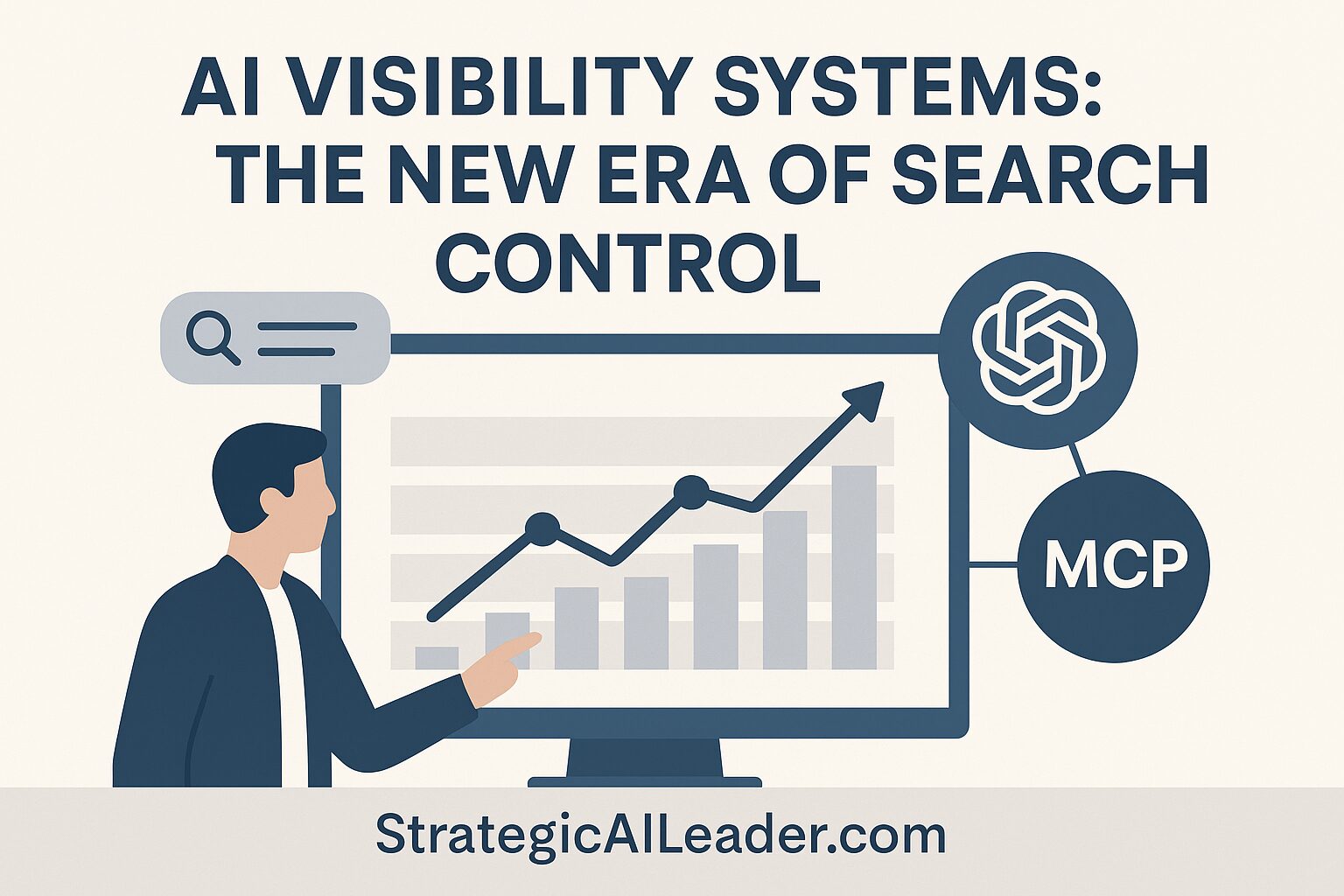The Three-Day Diagnosis That Could Have Taken Twenty Minutes
Your organic traffic drops 15 percent. Leadership wants answers. You spend three days inside Search Console exports, cross-checking crawl data, and comparing metadata across 200 URLs. Eventually, you find the culprit: Google stopped showing your featured snippets. Competitors still have theirs. You fix the technical issue, but you never understand why those snippets disappeared.
Most SEO teams stay trapped in reaction mode. Something breaks, everyone scrambles, a patch gets deployed, and the cycle repeats.
Search visibility stopped being a content problem. It has become a systems problem, yet most teams still use strategies built for 2019.
An AI visibility system, powered by ChatGPT’s Model Context Protocol (MCP), can surface entity mismatches within minutes. This system, while not designed to replace human review, can highlight issues early enough to prevent deeper losses. It’s important to note that AI works best when it reasons across your data infrastructure, rather than analyzing spreadsheets in isolation. In the context of SEO, ChatGPT and MCP play a crucial role in enhancing the efficiency and accuracy of your visibility operations.
The framework below shows how to turn ChatGPT from a content generator into your operational visibility co-processor.
Two Decades in SEO, and Why This Shift Feels Different
I have worked in SEO for more than twenty years. I have seen every algorithm update, every shortcut, and every reporting trend. The field evolved from keyword density to mobile-first indexing to entity-driven retrieval. Nothing compares to the transformation happening right now.
For the first time, modern toolsets allow us to see what we always suspected. We can trace visibility shifts across thousands of URLs, connect those shifts to entity signals, and test theories that once lived only in spreadsheets and hunches.
AI is not replacing SEO. It is expanding what SEO can measure. The work feels alive again. Practitioners can now test frameworks they refined over decades in real time. Watching those insights translate into measurable gains is what makes this profession exciting.
Marketing has always balanced science and intuition. The difference today is that science finally keeps up.
What Most Teams Still Get Wrong About SEO Operations
A talented SEO manager once presented a 47-slide audit deck. The visuals were sharp, the color-coding precise, and every recommendation ranked by impact. Two months later, nothing had changed. The deck sat in a SharePoint folder like dozens before it.
Audits die in spreadsheets because they reveal what changed, but not why. Analytics tools show falling impressions. Crawlers show schema errors. Rank trackers show position drops. Yet no system connects these signals into a coherent explanation that product or engineering can act on.
Traditional SEO reporting isolates each data source. You export from Screaming Frog, pull data from Search Console, and download GA4. Then you manually compare three different formats while trying to remember the site’s previous state. Human memory becomes the reasoning layer, and it is a poor database —at least, mine is. I have lost count of how many “final” spreadsheets I built to explain a ranking drop that lacked context.
ChatGPT with MCP closes those gaps. By linking Screaming Frog exports, Search Console APIs, and analytics data through live MCP connections, you give ChatGPT the context to query your complete visibility stack and explain why performance shifted.
BrightEdge reports that 68 percent of all trackable website traffic comes from organic and paid search combined. Despite this, most teams still diagnose visibility issues the same way they did five years ago. The cost of that delay compounds daily.
Why Visibility Systems Beat Visibility Reports
Our team used to run traditional monthly audits. Each cycle produced another static snapshot: a crawl, a list of errors, and recommendations that waited weeks for engineering time. Running more audits meant better control. It didn’t. It just meant more noise and slower decisions.
Eventually, we built what we called a visibility loop. The data sources remained the same, but ChatGPT began analyzing new data alongside historical patterns every two weeks.
The system didn’t only reveal what changed. It explained why visibility moved and how fast we responded.
Three operational metrics emerged:
- Visibility Stability measures how predictable impressions and clicks remain week over week. Track variance in impressions and CTR, normalized for seasonality.
- Decision Velocity measures the time between anomaly detection and the deployment of the fix.
- Reasoning Clarity measures how well AI explanations match analyst verification. Track the delta between model hypotheses and human confirmation to quantify improvement.
We reduced the average response time from twelve days to three. ChatGPT flagged issues in plain language that product and engineering immediately understood. No translation layer required.
A visibility loop operates like telemetry for marketing. Each data feed becomes a live context that ChatGPT interprets without forcing humans to jump between dashboards. Advanced Web Ranking data shows that pages ranking in the top three positions earn 54.4 percent of all clicks. Understanding why a page drops from position two to five matters more than simply noticing the drop.
The Five-Stage Visibility Loop Framework

Stage 1 – Ingest Clean Signals
Run Screaming Frog with GA4 and Search Console APIs enabled. Capture URL-level data, including metadata, clicks, CTR, and schema coverage in one unified crawl.
Configuration Checklist
- Connect GA4 and GSC APIs before crawling to embed engagement and query data.
- Limit the crawl to canonical URLs, excluding parameters and duplicates.
- Enable structured-data extraction for schema and entity fields.
- Save the configuration as a reusable template to maintain month-to-month consistency.
Comparable datasets beat larger datasets.
When I first automated this step, I expected clarity. What I got was chaos. The first merged dataset looked like a Jackson Pollock painting in Excel. The real breakthrough came when I started valuing consistency over coverage.
Running loops requires operational discipline. Even a lean team needs an analyst to maintain clean exports and prompt logs. The payoff comes through faster diagnosis and fewer wasted sprints.
Optional Automation – Python Collector
Use pandas, google-api-python-client, and gspread to merge Screaming Frog, GA4, and GSC exports. Keep fields consistent: URL, title, CTR, impressions, click depth, inlinks, and entity match score. Store the merged dataset in Drive, where MCP can access it.
If you need example code, visit StrategicAILeader.com/resources for ready-made ETL templates that handle merges and exports with clear comments for non-developers.
Stage 2 – Integrate Through Live Endpoints
Use Zapier’s MCP integration to link ChatGPT directly to your Drive or Sheets folder. Each dataset becomes a live endpoint that ChatGPT can query, subject to your permissions and refresh schedule.

You are not copying data; you are granting controlled access to structured inputs. MCP registers those endpoints so ChatGPT can analyze fresh data at any time. Governance and read-only scopes protect integrity.
MCP integrations are new, and setup takes patience. Expect permission friction, schema mismatches, and issues with prompt reliability. Treat the first iteration as a prototype designed to prove reasoning value rather than production readiness. Realistic expectations keep momentum high.
Stage 3 – Interpret With Reasoning Scope
Define the questions you want the system to answer.
Key Focus Areas
- Identify pages with stable impressions but declining CTR.
- Flag content missing schema or showing low entity match.
- Rank findings by visibility loss rather than keyword volume.
Prompt Template
“You are an SEO analyst reviewing monthly crawl and performance data. Compare impressions, clicks, and CTR to the previous baseline. Identify pages where engagement declined despite steady visibility. Summarize likely causes and rate confidence as high, medium, or low.”
Build your dataset with columns such as:
url, title, status_code, click_depth, inlinks, word_count, schema_types, entity_match_score, gsc_clicks_90d, gsc_impressions_90d, gsc_ctr_90d, ga4_sessions_90d.
ChatGPT uses relationships across these fields to reason, not guess.
Stage 4 – Iterate on Reasoning Quality
After every run, review ChatGPT’s findings. Determine which insights triggered meaningful action and which added noise. The first few loops will humble you. Mine certainly did. I thought my prompts were airtight until ChatGPT showed me how often my own definitions of “stable visibility” conflicted across runs.
Maintain a versioned Prompt Log to act as your visibility system’s memory. Track each run in a simple table or Notion database using these fields:
| Run ID | Date | Prompt Version | Dataset Source | Key Findings | Confidence Rating | Analyst Review Notes | Follow-Up Action | Outcome Next Cycle |
Each row becomes a retrievable case study. Store the table in Notion, Airtable, or a simple Google Sheet. Tool choice matters less than consistency. Over time, the Prompt Log serves as both a governance record and training corpus for improved reasoning.
Example of Evolution:
- Prompt v1: “Identify top pages with visibility loss.”
- Prompt v3: “Compare CTR delta by entity match score. Highlight commercial intent pages with ≥15% variance.”
- Each version learns from the last. Institutional reasoning strengthens as context compounds.
According to Ahrefs, 96.55% of pages get no organic search traffic from Google. That figure includes inactive or unindexed pages, but the trend illustrates the risk. A structured visibility loop keeps valuable content from joining that 90 percent.
Iteration teaches whether visibility gaps stem from technical debt, intent drift, or entity confusion.
Stage 5 – Inform Cross-Functional Action
Feed validated insights directly into your roadmap.
For example, ChatGPT might flag fifteen product pages with stable impressions but intent drift. Marketing reviews the messaging. Product checks for misaligned feature descriptions. Engineering verifies schema accuracy. One shared backlog replaces three disconnected task lists.
Teams running structured loops often cut diagnostic time by 20 to 30 percent and reduce false positives. They stop chasing phantom problems and start fixing genuine ones.
How AI Becomes Institutional Memory
Each loop trains both the system and the humans behind it. ChatGPT learns your visibility baseline and seasonal rhythm. Analysts learn to frame better reasoning prompts instead of static reports.
Visibility analysis becomes continuous. Context grows richer. Institutional memory lives in data, not in slide decks.
The first time I pinned a prior summary into a new run, it felt unnecessary, almost redundant. Then I realized I had stopped explaining the same background five times in a month. That is when I knew the system was learning faster than I was documenting.
Design the loop for retention. Each new analysis should reference the previous run. Pin the last summary, or include it in the system prompt, so ChatGPT can build on prior context rather than starting from scratch. Add a “Context Summary” tab to your Prompt Log that lists the last three insights with confidence scores. When the following analysis begins, the system recognizes established patterns. Over time, the AI and your team both understand what normal looks like and can detect meaningful deviation faster.
Operational Integration: Visibility as a Shared Metric
Host monthly “Visibility Review” meetings that bring together Marketing, Product, and Engineering.
- Marketing examines entity clarity and shifts in intent.
- Product connects visibility metrics to conversion behavior.
- Engineering validates crawl health and schema deployment.
A shared dataset fosters a shared language of reasoning. The visibility loop unites teams instead of dividing them.
GEO-OS Connection: Machine-Readable Trust
The same structured data powering your visibility loop also fuels your Generative Engine Optimization Operating System (GEO-OS).
Consistent schema and entity graphs improve how AI Overviews, Perplexity AI, and Google’s Gemini interpret and cite your content. The visibility loop becomes your trust layer across emerging AI search ecosystems.
Governance: Protect Integrity
Once ChatGPT connects to live data through MCP, strict governance ensures traceability.
- Limit connector access and refresh frequency.
- Version all prompts and outputs with timestamps.
- Require senior analyst approval before implementation.
Governance increases reliability rather than slowing progress.
Use a shared Drive folder with append-only permissions for audit logs. Each run saves a timestamped JSON output and a prompt version file. This lightweight workflow guarantees traceability without enterprise overhead.
Add a “reasoning review” step. When ChatGPT misinterprets a signal, record the correction. Over time, your error library sharpens both AI context and human judgment.
The Next Phase: Visibility Graphs and Interpretation Speed
By 2026-2027, leading organizations will maintain Visibility Graphs, structured maps showing how pages, entities, and metrics relate. Unlike a static data model, a Visibility Graph connects performance metrics, such as clicks and CTR, directly to content objects, such as schema types and entities. Each node carries attributes that AI systems can reason over. Think of it as the difference between a data table and a dynamic network that explains why metrics move together.

As more teams adopt visibility loops, competitive advantage will compress. The differentiator will become how quickly teams interpret signals and how cleanly their data structures support that reasoning.
Interpretation speed, not publishing speed, defines the next advantage. ChatGPT with MCP acts as a visibility co-processor, turning observation into explanation almost in real time.
Your First 30-Day Visibility Loop
Week 1: Run a baseline Screaming Frog crawl with GA4 and GSC APIs.
Week 2: Connect your Drive folder through MCP and test three diagnostic prompts.
Week 3: Compare current versus baseline data for one content cluster.
Week 4: Present the findings in a joint meeting across Marketing, Product, and Engineering.
Track time-to-insight as your primary metric. Aim to cut that cycle time in half by the third iteration. Each loop increases reasoning accuracy and institutional knowledge.
Conclusion: Systems Thinking Beats Reactive Reporting
Search visibility has evolved into a systems challenge where interpretation speed matters more than publishing volume.
When ChatGPT connects crawl, analytics, and search data through MCP, visibility becomes measurable, explainable, and repeatable. Operators who treat visibility as infrastructure, not reporting, will define the next era of SEO.
After two decades in this field, I still get the same buzz when data finally tells a clean story. The difference today is that the machine helps me see it faster, and sometimes it even catches what I would have missed.
Begin your first visibility loop. Measure how long it takes to move from data export to clear explanation, and then reduce that time by half.
Stay Connected
I share new leadership frameworks and case studies every week. Subscribe to my newsletter below or follow me on LinkedIn and Substack to stay ahead and put structured decision-making into practice.
Related Articles
AI Traffic in GA4: How to Separate Humans vs Bots
The Truth About AI-Driven SEO Most Pros Miss
Intent-Driven SEO: The Future of Scalable Growth
SEO Strategy for ROI: A Better Way to Win Big
Future of SEO: Unlocking AEO & GEO for Smarter Growth
Skyrocket Growth with Keyword Strategy for Founders
Unlock Massive Growth with This 4-Step SEO Funnel
About the Author
I write about:
- AI + MarTech Automation
- AI Strategy
- COO Ops & Systems
- Growth Strategy (B2B & B2C)
- Infographic
- Leadership & Team Building
- My Case Studies
- Personal Journey
- Revenue Operations (RevOps)
- Sales Strategy
- SEO & Digital Marketing
- Strategic Thinking
📩 Want 1:1 strategic support?
🔗 Connect with me on LinkedIn
📬 Read my playbooks on Substack

Leave a Reply